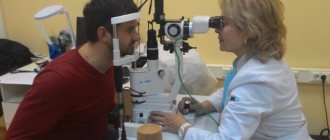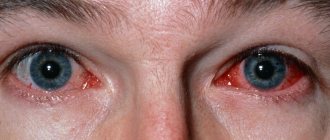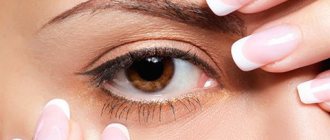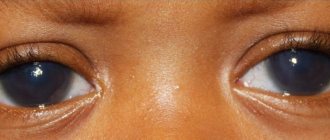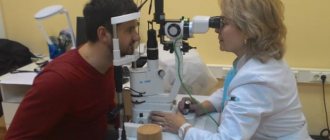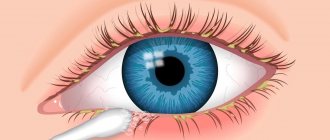As the body ages, older people can develop various diseases, and eye glaucoma is one of the most common. This disease affects more than 60% of patients over 50 years of age, but the first symptoms can be detected already at the age of 35 years. Let's talk in more detail about how to determine the onset of the disease and what methods are used to treat glaucoma in older people.
Main reasons
A provoking factor in the development of glaucoma is an imbalance between the produced and drained fluids, hence the increase in IOP. This kind of imbalance can occur in the eye socket in two ways:
- In a healthy person, fluid flows from the eye socket through a special channel. With the disease in question, this channel becomes clogged and fluid begins to accumulate in large quantities. Glaucoma begins to develop inside the eye socket.
- If fluid comes out freely in the amount it should, according to the norm, then an imbalance arises from an excessively large amount of fluid produced. This is another variant of the pathology, which belongs to the group of glaucoma.
The main causes of glaucoma:
Risk factors
Disputes around the causes of glaucoma do not stop among scientists. There are at least 25 theories about what factors influence and provoke the development of the disease. The approved factors were:
- Hereditary predisposition to glaucoma. The conclusion is made on the basis of statistical data. According to them, among all patients, a larger percentage are those whose parents suffered from glaucoma.
- Features of the eyeball associated with its anatomical structure. With a closed-angle shape of the anterior chamber of the eye, the passage for the outflow of fluid is narrowed, which causes its accumulation inside the orbit
- May be a concomitant disease. Glaucoma occurs in most people who have suffered from serious diseases such as stroke and heart attack. Also at risk are people suffering from diabetes, atherosclerosis and thyroid dysfunction.
- Old age is another factor contributing to the development of glaucoma. With age, the functions of the entire body begin to weaken. The condition of the eyeball also worsens, which leads to an increase in IOP.
- Mechanical damage. Burns, cuts, severe bruises - all this has a direct effect on the eyeball, on the generation of fluid or on the path of its exit. Mechanical damage can adversely affect the condition of the optic nerve and the function of the pupil.
- Inflammatory diseases provoke glaucoma. Such diseases include uveitis (inflammation of the vascular network of the eye), keratitis (inflammation of the cornea), iritis (inflammation of the iris).
- Drugs used to dilate the pupils. Such drugs are used during ophthalmological examination. The disease is provoked by the frequent use of such drugs.
- Tumor of the eye. Glaucoma can be caused by a malignant tumor (cancer), locally destructive (semi-malignant) or benign.
Diagnostics
Diagnosis of the disease in older people is carried out every 12 months. Every 6 months, testing is carried out for patients at risk - with diabetes, African Americans over 50 years of age and Hispanics over 65 years of age.
Diagnostics include:
- Tonometry. Measures intraocular pressure. First, drops are used to numb the organ of vision, then the doctor uses a special device that shows the exact parameters of IOP.
- Ophthalmoscopy. Used to examine the inside of the eye, paying special attention to the optic nerve. In a darkened room, the ophthalmologist uses an ophthalmoscope (an instrument with a light on the end) to determine the shape and color of the optic nerve. If it looks unusual, two more diagnostic methods will be performed - perimetry and gonioscopy.
- Perimetry - determines the field of view. Allows you to identify blind spots and determine how much peripheral visual perception has deteriorated.
- Gonioscopy is a painless test that checks whether the angle where the iris meets the cornea is closed or open. This method allows you to determine the type of glaucoma and prescribe more precise treatment.
What is needed to prevent glaucoma and cataracts?
Cataracts and glaucoma are socially significant diseases. These are one of the most common types of ophthalmological pathology, which have a chronic course and, in the absence of timely diagnosis and quality treatment, lead to disability.
Specific primary prevention of the development of cataracts and glaucoma, i.e., measures that help to reliably avoid these diseases, have not yet been developed. This is due to the large role of age and genetic factors in the formation of diseases that cannot be influenced.
However, there are general recommendations that will help maintain good vision:
Preventive examinations by an ophthalmologist. People who work with a computer or experience other types of eye strain on a daily basis are recommended to undergo preventive examinations with an ophthalmologist at least once a year. Similar recommendations are given to patients who suffer from diabetes and other endocrine diseases, as well as arterial hypertension. Moderate physical activity. Physical exercise and walks in the fresh air help reduce intraocular pressure, improve blood supply to the retina and optic nerve, and help slow down age-related changes in the lens (cataract prevention). Lifting heavy objects and standing with your head down for long periods of time should be avoided. Balanced diet. The diet should have enough protein, polyunsaturated fatty acids, fiber, vitamins and minerals. Cases of cachectic cataracts have been described in patients with nutritional deficiency. Therefore, there are no strict restrictions in the diet, but it is advisable to switch to a balanced diet with a predominance of vegetables and fruits, fish, cereals and whole grains
Diabetics should pay special attention to their diet and avoid sweet fruits (grapes, bananas), chocolate, jam, and baked goods to prevent cataracts.
Limiting harmful radiation. Glasses with sun lenses help avoid the damaging effects of UV radiation on the retina and the development of cataracts. When working with electric welding to prevent cataracts, it is also necessary to protect your eyes with special glasses to avoid occupational eye diseases
Microwaves and ultrasonic waves of certain frequencies can also have a negative effect on vision.
Treatment of ophthalmological diseases. Inflammatory eye diseases can be a trigger for the development of cataracts. Cataracts in the absence of surgery are often complicated by phacolytic glaucoma, and increased intraocular pressure with glaucoma can provoke the development of cataracts. Inflammatory and other painful processes in the eyeball often trigger a cascade of pathological reactions with the development of serious complications.
Therefore, preventing the development of cataracts and increased intraocular pressure involves treating ophthalmological diseases with the appearance of the first symptoms.
Modern research shows that diabetes mellitus increases the risk of developing complicated cataracts and glaucoma. Controlling glycemic levels can reduce the risks of these diseases.
Causes of glaucoma development in older people
The main mechanism for the formation of glaucoma in old age is aging - metabolic processes in the body slow down, the immune system weakens, and various chronic diseases begin to appear.
The direct cause in a significant proportion of diagnosed cases of pathology (up to 60 percent of all patients) is an increase in intraocular pressure. Additional negative provoking factors include:
- Diabetes mellitus of any type and severity, if recommendations for normalizing carbohydrate balance and other measures that prevent the development of complications of diabetes are not followed;
- Any ophthalmological pathologies, most often cataracts;
- Persistent circulatory disorders and hypertension;
- Diseases of the gastrointestinal tract;
- Renal or liver failure in the stage of decompensation;
- Bad habits – smoking and alcoholism;
- Other diseases, pathologies, syndromes that directly affect the quality of the visual system.
You can learn more about the causes and consequences of glaucoma here.
Treatment methods
Treatment of glaucoma in the elderly is carried out conservatively and surgically. The meaning of conservative therapy is to prescribe medications. The surgical method is surgical intervention at a late stage of the disease.
Conservative therapy
The purpose of using medications is to lower intraocular pressure and stimulate the production of ocular fluid. For treatment in the elderly, drops are usually prescribed, which are divided into the following types:
- Prostaglandins are drugs for hormonal-type glaucoma, aimed at reducing the intraocular pressure index.
- Beta blockers are prescribed to treat glaucoma to block the production of eye fluid.
- Alpha-adrenergic receptor agonists are drugs that reduce fluid production.
- Carbonic anhydrase inhibitors are prescribed for the treatment of glaucoma in order to inhibit and block the functioning of the glands responsible for the production of ocular secretions.
As you can see, all glaucoma medications have different effects, and it is not recommended to use them without a doctor’s prescription. Only after determining the cause of glaucoma and the degree of development of the disease will the doctor select an adequate treatment regimen and prescribe the necessary medication.
Glaucoma medications for the elderly are eye drops. There are no pills due to their ineffectiveness against this disease. The most common means to reduce blood pressure are:
- Aceclidine.
- Pilocarpine.
- Isopto carbachol.
Another group of glaucoma drugs stimulates ciliary receptors and belongs to prostaglandins. The most common means of this group are:
- Xalatan;
- Travatan;
- Taftolan;
- Timolol;
- Trusopt.
Separately, it is worth mentioning the use of Mexidol, an innovative drug related to inhibitors and used in neuroprotective therapy. For glaucoma, Mexidol protects the retina and optic nerve fibers from damaging external influences. The assessment of the effectiveness of Mexidol in the elderly is very high: computer perimetry study indicators improve, patients' visual acuity improves, and intraocular pressure decreases.
Surgical intervention
Surgical intervention is indicated for elderly patients for the treatment of glaucoma, when it is no longer possible to stabilize intraocular pressure and the outflow of aqueous humor with medication. During surgical intervention, traditional and laser surgery methods are used.
Traditional surgery
There are three types of operations against glaucoma:
- Trabeculectomy is the creation of additional holes within the trabecular meshwork. This technique is effective in 75% of all cases of surgical intervention, therefore it is considered the best method for treating glaucoma in elderly patients.
- Fistula installation is the placement of a drainage microtube in the area behind the conjunctiva to drain excess moisture.
- Viscocanalostomy is the least effective technique and is therefore rarely prescribed for the treatment of glaucoma in elderly patients. It consists in exposing the tissues responsible for filtering eye fluid.
Laser surgery
Laser surgery is increasingly replacing traditional surgery for the treatment of glaucoma in the elderly. Two types of operations are performed using a laser:
- Trabeculoplasty is often prescribed to elderly patients, as it effectively replaces traditional surgery. The essence of the method is to apply laser holes to the channels of the drainage system, the chambers of the eye are freed from moisture, and the pressure is reduced.
- Iridectomy - a procedure prescribed for angle-closure glaucoma. The essence of the method is to create a hole in the outer part of the iris. The operation is performed only after drug stabilization of intraocular pressure. For the treatment of glaucoma in the elderly, iridectomy is rarely performed, as it causes complications such as cataracts.
Non-penetrating operation
Folk remedies
Elderly people tend to resort to folk remedies, without thinking that glaucoma is a disease that cannot be cured even with complex therapy. Traditional recipes are good for prevention, as well as together with medications. An ophthalmologist will determine the causes of glaucoma in an elderly patient, prescribe eye drops and evaluate the benefits of this or that folk remedy.
For eyes with glaucoma, decoctions of parsley, nettle, carrots, and honey are made and used for rinsing and instillation.
Herbal decoctions contain vitamins and beneficial microelements that will strengthen the organs of vision, but without drug therapy they will not be able to stop the development of the disease in older people. Do not self-medicate, be sure to consult a doctor for advice!
Folk remedies for getting rid of the problem
- Treatment of glaucoma in older people with folk remedies is considered the most common. Many people prefer to eliminate it with beekeeping products. In general, various pathologies can be treated in this way. It is recommended to use honey to make lotions. To prepare the healing product, you need to dilute it with warm water in a 1:1 ratio. Then you need to take small pieces of gauze and soak in this mass. After which they should be applied to the eyes. Pollen also helps a lot. It can be easily found at the pharmacy. You can also use honey as drops. To do this, the pure product must be heated in a water bath. The liquid product can be instilled into the eyes. You can also drink a glass of drink on an empty stomach, which contains honey and apple cider vinegar in equal proportions.
- Pomegranate juice also has medicinal properties. You can prepare a remedy from it and a large spoon of honey. These ingredients need to be mixed and put on low heat. Cook the mixture for 15 minutes and cool. Apply the product to the eyes.
- An excellent way to warm up the organs of vision is boiled protein.
- Dill seeds are of great benefit. You will need a small spoon of seeds. They need to be filled with a glass of boiling water. You need to drink the prepared product daily, a large spoon three times before meals.
- If glaucoma appears in older people, how else can it be treated? Healing herbs can help with this. It is recommended to wash your eyes with chamomile or nettle.
- You can prepare a decoction of aloe. To do this you will need a couple of plant leaves and a glass of water. Combine all ingredients and boil. The finished broth must be cooled and strained. You can wash your eyes with this product.
Causes of the disease
Intraocular pressure increases when fluids produced in the eye lose their ability to leave the eye along their normal path, known as the open angle between the iris and cornea.
They accumulate in the eye, which leads to increased pressure. However, in the case of normal pressure glaucoma, the cause of damage to the optic nerve is not always clear.
In a healthy eye, a certain pressure is constantly maintained (18-22 mm Hg) due to the balance of fluid inflow and outflow. With glaucoma, this circulation is disrupted, fluid accumulates, and intraocular pressure begins to rise.
The optic nerve and other structures of the eye experience increased stress, and the blood supply to the eye is disrupted. As a result, the optic nerve atrophies and visual signals stop reaching the brain.
A person begins to see worse, peripheral vision is impaired, as a result of which the area of visibility is limited - and eventually blindness may occur.
Risk factors
Glaucoma is the second most common cause of blindness in the world. Because the signs and symptoms of glaucoma are often subtle, it is called the “silent thief of vision.”
It is recommended that everyone undergo regular glaucoma screenings as part of a comprehensive eye exam, especially if they have one or more risk factors for glaucoma. Risk factors for glaucoma vary depending on the type of glaucoma.
With glaucoma, there is a violation of the circulation of intraocular fluid, an imbalance between its inflow and outflow, as a result of which IOP increases. Increased IOP puts pressure on the optic nerve and gradual death of its nerve fibers occurs (optic nerve atrophy).
Consequences This inevitably leads to a narrowing of the visual fields: both central and peripheral (lateral).
Glaucoma usually occurs due to increased intraocular pressure (IOP). At the front of the eye, between the lens and the cornea, there is a small space called the anterior chamber. A transparent liquid circulates in it, washing and nourishing the surrounding tissues.
When intraocular fluid begins to flow too slowly from the anterior chamber, its accumulation causes an increase in intraocular pressure.
The most common is primary open-angle glaucoma (POAG). Forms of glaucoma such as angle-closure, normotensive, congenital, pigmentary, secondary and others are less common.
Symptoms of glaucoma
The symptoms of glaucoma depend on its type. There are open-angle and closed-angle forms.
In the elderly, an open-angle shape is often observed. It is dangerous because its signs are difficult to recognize at the very beginning, so people usually seek help at a time when the disease has already progressed.
Open-angle glaucoma is accompanied by blurred vision, colored circles, migraines, blurred vision, and a feeling of pressure in the eyes and above the eyebrows.
The closed-angle form is less common. Pain may occur from the first day. It is important to be treated on time to avoid vision loss. This type has a congenital character: the iris blocks the outflow of intraocular fluid due to anatomical features. More common in older women. Angle-closure glaucoma is accompanied by blurred vision, nausea and vomiting, impaired coordination, and intraocular pressure.
There are also other types of glaucoma:
- Complicated open-angle glaucoma with normal pressure. It is believed that this disease is provoked by impaired blood supply to the optic nerve;
- Secondary glaucoma due to ocular trauma;
- Pigmentary glaucoma is observed in men over 40 years of age and occurs rarely. The reason for the development is the leaching of pigment from the epithelium of the iris;
- Congenital glaucoma. Develops in the fetus growing in the mother's belly.
Glaucoma is a bilateral disease. If it appears on one eye, it will appear after some time (several years) on the other.
If a person has these signs, they may be developing glaucoma:
- pain and pain in the eyes;
- blurred vision;
- the appearance of colored circles before the eyes;
- blurred vision and dark spots in the field of vision;
- redness and increased tone in the eye area;
- pressure on the eyeballs;
- attacks of nausea and vomiting;
- narrowing of visual fields;
- feeling of heaviness and fullness;
- decreased ability to see at dusk.
Be sure to send the pensioner for examination to an ophthalmologist! In any case, in people over 60 years of age, intraocular pressure is measured to monitor the condition of the eyes.
Prevention
For early diagnosis and prevention of glaucoma, older people are recommended to:
- undergo examinations at least four times a year over the age of 60, twice a year from 50 years of age, annually upon reaching 40 years of age;
- follow a diet, introduce vegetables, fish, cottage cheese, lean meat into the diet;
- stop drinking alcohol and smoking;
- do not lift weights exceeding 10 kg;
- Refuse to work that requires an inclined body position and prolonged eye strain.
Now you know what are the causes of glaucoma in older people, and what should be the preventive measures for this disease.
Don't neglect visiting your doctor! Therapy at an early stage will bring maximum effect and help stop the development of the disease!
Types of senile glaucoma
The most common is primary open-angle glaucoma, which leads to complete loss of peripheral vision. About 1% of the Russian population suffers from this type.
The second common type of disease is acute angle-closure glaucoma. At least 200,000 residents of the Russian Federation suffer from it.
Pigmentary glaucoma is less common in older people. This type is mainly characteristic of men suffering from myopia. In women, pigmentary glaucoma is extremely rare.
Forms of the disease
There are several different forms of glaucoma. The most common is the so-called open-angle glaucoma.
In addition, in recent years, glaucoma with normal intraocular pressure has captured the attention of doctors.
A third of cases of open-angle glaucoma belong to this form of the disease.
As the name suggests, with this type of glaucoma, intraocular pressure remains normal, and damage to the optic nerve is caused by disorders of the vascular system, which, as a rule, manifest themselves not only in the eye, but throughout the body.
It can develop, for example, with severe inflammation of the eye, vascular occlusions, and also accompany diabetes mellitus or occur after severe eye injuries.
Open-angle glaucoma and glaucoma with normal intraocular pressure together account for more than 90% of all cases of this disease. Only a specialist can give an accurate diagnosis and definition of the disease.
There are three types of this disease:
- A congenital anomaly caused by the peculiarities of the embryonic period, a consequence of injuries and past illnesses. May be a contributing factor to other eye diseases.
- Primary glaucoma occurs most often in patients over forty years of age. Caused by dysfunction of the outflow of fluid in the eye chamber. It is the most common form of glaucoma.
- Secondary glaucoma manifests itself against the background of concomitant eye diseases, injuries or previous operations. In this case, it is necessary to use anti-glaucoma drops.
- In addition, there are closed-angle (impaired visual function) and open-angle (the disease is asymptomatic, determined by pathologies of the drainage system) glaucoma.
Both conditions require urgent medical attention. With this disease, vision declines very quickly and most often the processes are irreversible. To effectively restore visual acuity, surgical intervention is considered the most effective.
Maybe
Causes
The exact causes of glaucoma have not yet been established. However, increased intraocular pressure, which damages the optic nerve, is an important risk factor for this disease.
Also, high blood pressure and limited blood supply (eg, diabetes) can contribute to the development of glaucoma.
In addition, recent ophthalmic research has shown that the brain fluid surrounding the optic nerve may also be involved in the development of glaucoma; Immune system disorders can also affect the occurrence of this disease.
In order for glaucoma to arise, develop and develop into a chronic form, there must be a number of reasons, and not just one, but several at once, which together provoke the disease.
The mechanism of the disease glaucoma, provoked by a number of reasons, is simple; the main reason that leads to the formation of the disease is considered to be a violation of fluid circulation.
It begins to accumulate inside the eye, thereby increasing pressure and putting stress on the optic nerve. The nerve may not be able to withstand the constant load of fluid, which will provoke a violation of blood circulation, and this, in turn, will cause atrophy of the optic nerve and deterioration of vision.
Causes of glaucoma:
- Increased pressure inside the eyeball.
- Disorders of fluid outflow.
- Poor blood circulation in the eye apparatus.
- Compression and atrophy of nerve fibers.
- Destruction and dystrophic processes in visual fibers.
- Concomitant diseases of the ocular apparatus.
- Hereditary factors.
- Diabetes.
- Hypotonic states.
- Diseases of the thyroid gland and central nervous system.
Congenital glaucoma occurs most often after infectious diseases suffered during pregnancy. Predisposition to the disease can be inherited.
Recommendations
Do not press or rub your operated eye.
During the first nights after surgery, wear an ointment bandage to protect your eye. When taking a shower, be careful not to splash water on your face. Tilt your head back when washing your hair. In the first days after glaucoma surgery, do not put excessive strain on your eyes, and avoid reading too much and watching TV. Resume exercise and sports such as swimming and diving only after consulting with your doctor.
The same applies to visits to the sauna. Discuss with your eye doctor personally when you can go back to work and when you can drive again. Do follow-up postoperative and ongoing examinations with your ophthalmologist; take the medications prescribed to them. If you notice blurred vision, severe redness or pain in your eye during the first time after surgery, contact your ophthalmologist immediately.
As for laser surgery, its main advantages include a short rehabilitation period, good outpatient conditions and only local anesthesia when using this technique.
The main disadvantage of laser surgery for glaucoma is the limited effect, since in more mature stages of this disease only radical surgery is used.
When a surgical treatment method is used, the doctor can use several types of techniques, these are sclerectomy, trabeculectomy, iridocycloretraction and iridectomy or others.
It is worth knowing that there is no single standard for the use of a certain type of surgery for glaucoma. As a result, in each specific case, the doctor selects the type of operation for this disease individually.
Surgical treatment of glaucoma is a rather complex and risky approach, and complications after such surgery are not uncommon. There are several methods of surgical treatment of glaucoma.
One of the common methods is a low-traumatic intervention called non-penetrating deep sclerectomy.
To do this, the excretory tubules are expanded and the filter diaphragm is washed with a special solution. An elastic preparation is injected into the tubules, “pushing apart” the walls of the tubules and forming a wider lumen.
As a result, the throughput of the diaphragm and tubules increases. This technique usually does not cause complications, and there can be only one unpleasant consequence - insufficient reduction in pressure after surgery, since the outflow of fluid is still insufficient.
Outdated techniques involving penetration into the eyeball are also currently used. Complications after such operations are more significant - for example, blood entering the vitreous body or the anterior chamber of the eye.
Important A common complication after surgery for glaucoma is an excessive decrease in intraocular pressure without normalizing it. Over time, this condition leads to degenerative processes in the cornea of the eye.
The main symptoms of the complication are blurred vision and discomfort in the eyes. The reasons for an excessively strong decrease in pressure are various: detachment of the choroid, a sharp outflow of intraocular fluid, etc.
Correction of the complication is also carried out surgically after identifying the cause: the drainage channel is narrowed, choroidal detachment is eliminated, accumulated fluid is removed, etc.
As a rule, complications after surgery are detected after 2-3 days, sometimes a week. However, when using outdated surgical techniques for treating glaucoma, long-term consequences are possible.
In the early postoperative period, complications are also possible: the development of an inflammatory process, pupillary block, etc.
Treatment of complications is carried out in the same hospital where the operation was performed and takes about 4-6 days. Glaucoma is the general name for a group of eye diseases characterized by increased pressure inside the eye and damage to the optic nerve. The danger of glaucoma is its inconspicuous course.
Most often, the disease is asymptomatic for a long time. Meanwhile, irreversible processes occur, due to which a person’s vision gradually deteriorates, and over time he can become completely blind.
Methods of surgical treatment of glaucoma
Various surgical methods can be used to treat glaucoma. Glaucoma surgery can be performed traditionally or using a laser.
Laser treatment
Laser treatment of glaucoma is the safest method of surgical intervention. Modern clinics offer the following types of laser surgery:
- Non-penetrating deep sclerectomy (NPDS). How is eye surgery done? The surface of the peripheral portion of the eyeball becomes thinner, allowing natural restoration of the outflow of ocular fluid without the need for opening. Helps even in the earliest stages of the disease.
- Iridectomy. A microscopic hole is created in the iris, through which the natural outflow of intraocular fluid is normalized. Performed under local anesthesia.
- Trabeculoplasty. The trabecula of the eye is affected by many microscopic laser burns, which contribute to the tension of the diaphragm and improve the outflow of intraocular fluid.
- Cilioablation. The ciliary body of the eye, which is responsible for the production of intraocular fluid, is destroyed, which provokes the normalization of IOP.
How many days in the hospital do you need to spend for surgery? Laser surgery for glaucoma is a minimally invasive surgical procedure, which is most often performed under local anesthesia on an outpatient basis on 1 day.
The recovery period proceeds quickly and without complications.
Classic surgery
If laser surgery cannot be performed for some reason, then traditional surgical treatment is prescribed, in which the eyeball is opened and the abnormalities are eliminated. The following types of operations can be performed:
- Trabeculectomy. How is glaucoma surgery performed? Normalization of the outflow of intraocular fluid is carried out by excision of part of the clogged drainage system located in the corner of the anterior chamber of the eye. Instead of the removed area, a small bubble is formed, ensuring the normalization of the balance of the ocular fluid.
- Viscocanalostomy. A small part of the sclera is excised and the eye fluid is filtered through a thin layer of tissue.
- Implantation of drainage systems. An artificial drainage system is introduced into the structure of the eye, ensuring the outflow of fluid from the anterior eye chamber. Shunt devices can be simple (tubes) or complex (tube connected to a plate). The most popular implantation device is the Ahmed valve. With such an operation, the service life of the Ahmed valve is several years.
- Iridocycloretraction. Between the trabecula and the root part of the iris, 2 strips of sclera are inserted for fluid outflow.
At what eye pressure is glaucoma surgery indicated?
Anti-ulaucomatous surgery must be performed if the level of ophthalmotonus exceeds 30 mm Hg. Art. Urgent surgery is necessary in case of an acute attack of glaucoma, when the pressure rises to 60 mm Hg. Art. The operating method is selected individually by an ophthalmologist-surgeon, taking into account the stage of the disease and many other nuances.
Treatment of an acute attack of angle-closure glaucoma
With a critical increase in intraocular pressure (40-60 mm Hg and above), emergency medical attention is required. If the pressure does not decrease over the next 24 hours, the patient may completely lose vision.
The patient receives drops of the miotic Pilocarpine 1% or 2%. At the same time, a solution of Timolol 0.5% is injected into the eye. The patient takes Diacarb internally. Diuretics (50% glycerol solution) are administered intravenously. If treatment does not produce results, an intramuscular injection is given of a mixture of Aminazine solution 2.5%, Diphenhydramine solution 1% or 2% and Promedol solution 2%. The composition can cause a rapid drop in not only eye pressure, but also blood pressure. Therefore, after the injection, you need to remain in bed for at least 4-5 hours.
As auxiliary measures to stop a dangerous attack, it is recommended to steam the legs, give saline laxatives, apply mustard plasters or cups, and also apply leeches to the temples.
To reduce the critical pressure in the eye and prevent the occurrence of a recurrent attack, laser iridectomy is performed on both the affected eye and the healthy one.
Secondary prevention of glaucoma
Secondary prevention of glaucoma is prescribed if the disease has already entered its active phase. The recommendations below will help stop the progression of the lesion and avoid acute attacks of glaucoma. This:
- Medications. The patient should visit the doctor periodically and follow all the recommendations he gives. As a rule, ophthalmologists prescribe various eye drops and medications to nourish the retina.
- Dieting. As the disease progresses, you should completely avoid alcohol, salty and pickled foods. You should not drink more than two liters of water per day.
- Decreased physical and emotional activity. Patients with progressive glaucoma should avoid visual strain. In addition, it is dangerous for them to work in dim light, with a strong tilt of the head, in too low and high temperatures.
Stress negatively affects the optic nerve, so if possible, it should be avoided in every possible way.
Therapeutic drops against glaucoma
It’s worth looking at the use of drops in more detail. There are 4 types of drugs that an ophthalmologist can prescribe:
- To reduce the production of intraocular fluid. These drops prevent the active formation of aqueous humor from blood plasma.
- For active outflow of fluid from the eyeball. The drug constricts the pupil and opens a channel for the release of intraocular fluid (Schlemm's canal).
- Combined action. The drug combines the effects of the two previous drugs.
- Eye protection. Such drops help protect the cells and fibers of the optic nerve from injury when intraocular pressure increases.
Medicines of any nature must be prescribed by a doctor.
Agents that inhibit the production of intraocular moisture
Selective sympathomimetics. The drugs reduce the intensity of aqueous humor production and increase uveoscleral outflow. These include clonidine (Clonidine 1.125%, 0.25%, 0.5%), apraclonidine, brimonidine. Clonidine is not prescribed to patients with high blood pressure. Apraclonidine and Brimonidine have virtually no negative effects on blood pressure, heart rate and nervous system. Selective medications also include betaxolol (Betoftan, Xonef, Betalmik EC). Patients with asthma and bradycardia are not prescribed beta-blockers. Considering that the drugs can cause a significant decrease in blood pressure, it is not recommended for hypotensive patients to take them.
Beta blockers. Medicines are divided into non-selective and selective. Non-selective drugs reduce the secretion of aqueous humor without causing pupil constriction or affecting blood pressure. Such drugs can be taken by people suffering from hypertension. These include Anaprilin 1%, Timolol 0.25% and 0.5%.
Carbonic anhydrase inhibitors. They significantly reduce the production of aqueous humor. These include dorzolamide (Trusopt 2%), brinzolamide (Azopt 1%).
When prescribing drugs that suppress the secretion of aqueous humor, their side effects must be taken into account. An excessive decrease in the production of eye fluid can cause a change in its biochemical composition. Such disorders can negatively affect organ tissue and metabolism in them.
